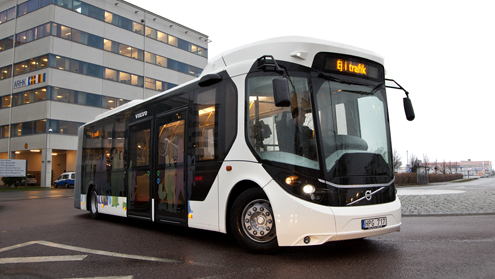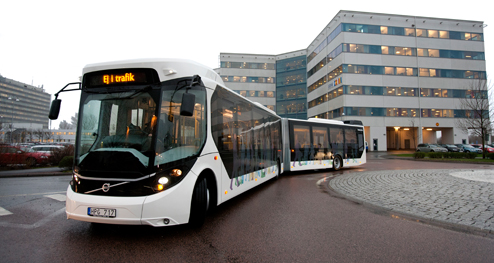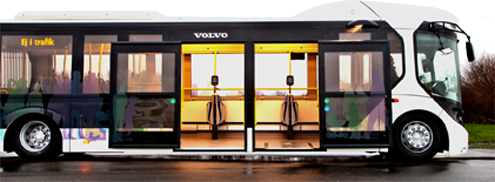
By Doug Jack

The International Union of Public Transport (UITP) is coordinating a major project in the European Union (EU) to develop the European Bus System of the Future (EBSF). The EU has extended funds to the 49 organizations taking part, which include all the main bus manufacturers, component and systems suppliers, as well as universities and research organizations.
System is the key word in this project. It is not about the development of a new generation of buses in isolation, but about raising the image of bus services and improving the total transport experience for passengers.
Many European cities are old with historic centers and consequent challenges like narrow streets and limited parking for private cars. One of the main objectives is to improve point-to-point journey times for passengers by a combination of features. Buses must be easily accessible, so passengers can get on and off quickly. Other measures, like automatic ticketing, dedicated bus lanes and priority at traffic lights and intersections can all contribute to more rapid journeys.
Volvo Bus Corporation unveiled its interpretation of the EBSF in its home city of Gothenburg, Sweden in December. Volvo already has experience with 60-ft articulated and 80-ft bi-articulated buses running on one of the busiest routes in the city. Those vehicles have an unusual layout, with the engine mounted on the offside, behind the first axle, driving into the second axle, therefore simplifying the articulation systems for the single or double trailers, each of which has a further non-driven axle.

At first sight, the Volvo prototype looks quite unusual. It is based on a standard articulated single deck underframe with the engine mounted offset in line at the rear, driving into the third axle. The prototype uses a standard 9-liter engine driving through a ZF fully automatic six-speed gearbox to a drop center rear axle.
However, the front axle is farther forward, and the driver’s seat is located centrally over the front wheels.
On a normal Volvo city bus there is usually one double-width door ahead of the front axle and a second similar door just ahead of the second axle, plus one or two doors in the trailer section, depending on customer preference.
On the prototype, the two double-width single-piece doors slide outward. The front door moves forward, the rear moves backward, creating enough space for four passengers to enter at once, while a passenger in a wheelchair could be taken on and off by a ramp at the forward of the two doors. This layout looks like it could challenge the heating system, especially in the depth of winter in Gothenburg when icy winds blast in from the North Sea. There are also two double-width doors in the trailer section.
Volvo, Chalmers University and the local public transport authority, Vasttrafik, carried out extensive trials and found that the novel layout gave a superior and more even flow of passengers in and out compared with existing layouts, thus reducing time spent at bus stops.
The contribution by Chalmers University is very interesting. Engineers developed a wooden mockup of the layout of the interior of a bus, with door positions, seats and ticketing equipment. They monitored the behavior of different types of passengers ranging from students to mothers with strollers and people carrying luggage. They applied this research to different potential bus layouts to come up with what they believed was the optimum flow of passengers on and off the vehicle.
By relocating the front axle farther forward, Volvo has also been able to provide more seats in the front section of the bus. Total capacity of seated and standing passengers, increased by 25 percent from 116 on a standard articulated bus to 147 on the prototype without any increase in overall length. One novel feature is the use of tip-up seats in the front area that can lock into the closed position at peak periods to create more standing capacity.
At the front of the bus a large one-piece windshield is almost vertical and does not look aerodynamic. However, as city buses never reach high speeds, this is probably not a consideration.
I have reservations about locating a driver in a separate compartment. Some of the most successful European bus companies are investing heavily in driver training, teaching them to be friendlier to passengers. The Volvo location makes communication more difficult, but not impossible. While the driver is still visible, some might argue the partition gives protection from unruly or unpleasant passengers.
The central driving position also assumes the vehicle will operate much of the time on a dedicated right of way, free from obstruction by other vehicles. While the driver could see over a parked car, it would be more difficult to see round an obstruction like a van or a truck.
The long wheelbase in the front section of the vehicle will impair maneuverability, particularly on tight turns, which means routes will need to be checked carefully. However, that should not be a problem on a Bus Rapid Transit system where the right-of-way should be able to accommodate the layout. The longer wheelbase should also provide a more comfortable ride for drivers and passengers.
The prototype vehicle will enter service on the busiest route in Gothenburg currently served by 20 bi-articulated Volvo buses every five minutes.
Seven cities around Europe are taking part in the EBSF project, looking at different solutions and problems. These include passenger information systems, advanced traffic management, lighting which indicates whether there are any available seats, remote diagnostics, preventive maintenance, increased service efficiency, ease of getting on and off the vehicle, and real-time information advising on other modes of transport.
The research program is due for completion in September with a full report published thereafter. It should make interesting reading, but with the current deep economic crisis in some European countries, it might be many years before new systems become widespread.
It is also significant that the Volvo prototype can accommodate gas and hybrid drive systems. In Sweden there is strong interest in biogas because it is a renewable source of energy. Neighboring Norway has abundant supplies of natural gas in the North Sea.
Most other European countries share an interest in hybrid buses. Volvo has developed its own ISAM parallel system for used not only in buses but also local distribution trucks and construction equipment, giving the company economies of scale in production. More than 350 Volvo hybrid buses are now in service in several European countries, and the company has sent prototypes to India, Brazil and Mexico.

Some people see hybrid as simply a step towards all-electric buses. At the moment, batteries do not have sufficient range for a full day’s work on a large transit bus. Volvo recognizes that challenge and has set up a joint venture with Shanghai Automotive Industry Corporation in China to develop battery technology and all-electric vehicles. Already, buses can connect to overhead power points that provide a fast booster charge at the end of each route and at busy stops along the line. Regular fast charging is helping to extend the mileage range. Because Volvo built the EBSF prototype on a standard platform it will be easier to introduce new technology and drive systems as they become available and at customers demand. BR
Doug Jack is with Transport Resources in the United Kingdom.
